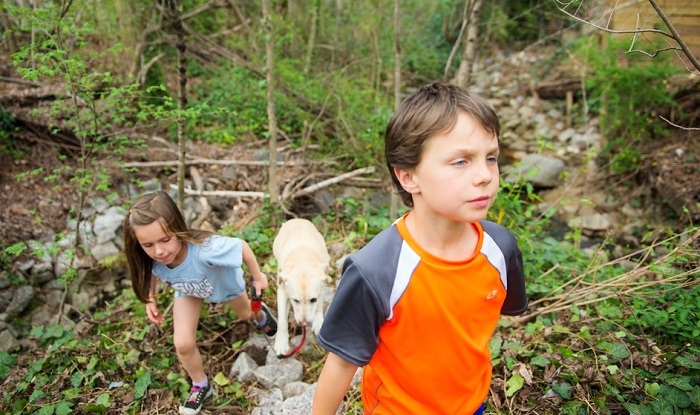The Vital Importance of Outdoor Play for Our Kids
If you’ve only read our posts on gardening or chickens you may have missed the fact that the primary reason that Britt and I embarked on this RYG journey was to help get people outside more at home…to connect with their family, friends, neighbors, and nature. We believe that when you do that your life will be changed for the better. And the two little muses that keep us going down this path so intentionally are our scrumptious daughters…our family’s outdoor play champions. Which…if you read a bit further, you’ll see why I was so excited when I found National Wildlife Federation’s™ Be Out There™ site.
As Be Out There™says on its home page, “Spending time outside is good for mental and physical health. Even more, it’s FUN and helps kids build a lasting connection to nature.” And we’d just go on to add that being outside with others…engaging in all forms of outdoor play – connecting, inspiring, challenging, and just hanging out…makes it that much more life-giving…that much more soul-filling.

![]()
One article on the Be Out There™ site that I found particularly compelling is called Whole Child: Developing Mind, Body and Spirit through Outdoor Play. Published in 2012, this article drives home the point about how vitally important outdoor play is for our kids. The picture they paint is concerning to say the least…and if you’re a parent with kids who spend most of their time inside and you’re not moved to make a change after reading their article, I’d suggest you check your pulse to see if you’re alive.

I’ll provide you with a handful of quotes from Whole Child only as a teaser…hoping that you’ll click over there for yourself to read all 16 pages.
- While contemporary parents spent their free time as kids exploring and playing in nature, their children devote only four (1) to seven minutes a day (2) to unstructured outdoor play like climbing trees, drawing with chalk on the sidewalk, taking a nature walk or playing a game of catch. Yet, kids spend more than seven hours each day in front of electronic media. (3) (Page 1)
- While not considered a cure, exposure to natural settings may be ‘widely effective’ in reducing ADHD symptoms in kids, according to the University of Illinois. (4) (Page 3)
- A 2004 study supports the positive effect of environment-based education on learning, specifically its ability to boost critical thinking. (5) (Page 4)

- Children raised indoors are at risk for serious health problems, and it’s not a matter of when these problems will arrive; they’re already here in the form of obesity, vision problems, vitamin D deficiency, and diabetes. For instance, ‘In the last 20 years, the prevalence of obesity among young children aged 6 to 11 has more than doubled to 17 percent and more than tripled to 17.6 percent for adolescents aged 12-19.’ (6) (Page 5)
- Antidepressant use is on the rise according to a four-year study that examined antidepressant use among approximately two million children under the age of 18. Over the course of the study, antidepressant use increased by 49%, with the fastest growing segment of users found to be preschool children aged 0-5 years. (7) (Page 7)
- An American Academy of Pediatrics 2007 report on the importance of play points out that play protects children’s emotional development whereas loss of free time in combination with a hurried lifestyle can be a source of stress, anxiety and may even contribute to depression for many children. (8) According to one study, children’s stress levels fall within minutes of seeing green spaces, a simple, no-cost and time-efficient antidote for stressed out kids. (9) (Page 7)
Alright…that’s as much as I’m going to give you. But what you’ve read so far should at least get you to go see the rest of the article for yourself. I hope that you do…for the sake of your kids, I hope that you do. And then after reading it you’ll do what you can to make outdoor play a priority for your family. ![]() Other Related RYG Posts
Other Related RYG Posts
- Why Redeem Your Ground? Your Kids.
- Do You Know Where Your Kids Are?
- Get Outside & Play!
- What’s Your Family Story?
- The RYG Video
- All things PLAY on RYGblog
I hope you have a good rest of your week and weekend…and that you’ll take some time to get outside.
Take care,

References
- Hofferth, Sandra and John Sandberg (1999), “Changes in American Children’s Time, 1981-1997,” University of Michigan Institute for Social Research.
- Juster, F. Thomas et al. (2004). “Changing Times of American Youth: 1981-2003, “Institute for Social Research, University of Michigan. http://www.umich.edu/news/Releases/2004/Nov04/teen_time_report.pdf
- Rideout, Victoria et al. (2010). “Generation M: Media in the Lives of 8-18 Year-Olds,” The Henry J. Kaiser Family Foundation. http://www.kff.org/entmedia/entmedia030905pkg.cfm
- Kuo, PhD. Frances e., & Andrea Faber Taylor, PhD. “A Potential Natural Treatment for Attention-Deficit/Hyperactivity Disorder: Evidence From a National Study.” American Journal of Public Health 94.9. Sept. 2004. http://www.pubmedcentral.nih.gov/articlerender.fcgi?artid=1448497
- Ernst, Julie (Athman) & Martha Monroe. “The effects of environment-based education on students’ critical thinking skills and disposition toward critical thinking.” 10.4 Environmental Education Research, Nov. 2004.
- CDC’s National Center for Chronic Disease Prevention and Health Promotion. Division of Adolescent and School Health. Childhood Obesity. 20 Oct. 2008. http://www.cdc.gov/HealthyYouth/obesity
- Delate, T., Gelenberg, A.J., Simmons, V.A., & Motheral, B.R. (2004) “Trends in the sue of antidepressant medications in a nationwide sample of commercially insured pediatric patients, 1998-2002.”
- Ginsburg, MD MSEd, Kenneth R. Committee on Communications, and Committee on Psychosocial Aspects of Child and Family Health. “The Importance of Play in Promoting Healthy Child Development and Maintaining Strong Parent-Child Bonds.” 119.1
- Kuo, PhD. Frances e., & Andrea Faber Taylor, PhD. “A Potential Natural Treatment for Attention-Deficit/Hyperactivity Disorder: Evidence From a National Study.” American Journal of Public Health 94.9. Sept. 2004. http://www.pubmedcentral.nih.gov/articlerender.fcgi?artid=1448497
You may also enjoy these posts from RYG ...
If you're not already subscribed to RYG and want to get periodic updates, links to new posts & other ground redeeming info ... just enter your email address below. Easy as that!



![Natural Play Spaces – Best for Your Kids’ Bodies & Minds [Guest Post by Holly Brooks | King Landscaping]](https://redeemyourground.com/wp-content/uploads/2015/07/Natural-Play-Spaces-RYGblog3-150x150.jpg)

